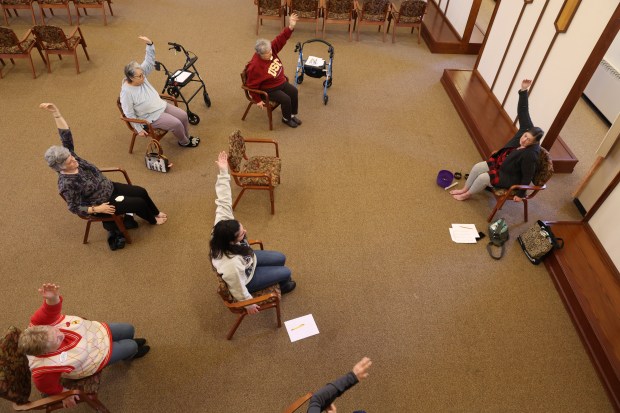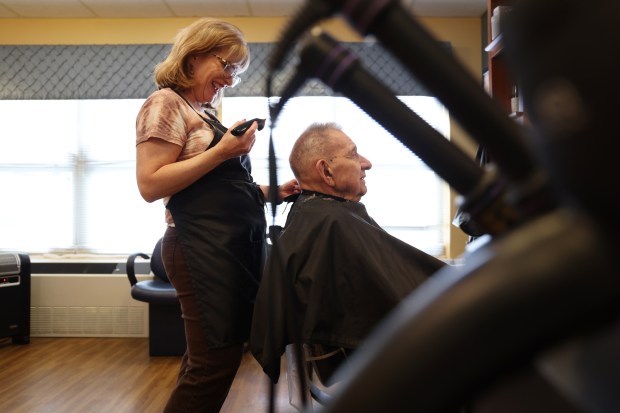Continuing care retirement communities offer seniors their own home, meals and activities, and assisted living or nursing if they need it. They can accommodate residents who range from being independent to those who require 24-hour care.
Also known as life plan or life care communities, they require a hefty entrance fee, often ranging from $250,000 to $400,000 or more , plus significant monthly payments. When a resident leaves or dies and their unit is resold, depending on the contract, that fee may be repaid to the family at up to 90%.
So when residents of The Oaks at Bartlett were called into meetings with management in December and asked to sign agreements to reduce the refund on their entrance fees to as low as 30%, they were upset.
“People are scared to death,” said Rick Stanko, whose parents lived in The Oaks. “People like my parents, they did the right thing their entire lives. They saved and prepared, and lived within their means. Passing on money to descendants was important to them.”
With more than $50 million owed in entrance fees, the full amount is unlikely to be fully repaid.
The Oaks, with more than 250 residents, continues to operate normally, but is shifting to a new business model. It’s offering lower entrance fees, in the $100,000 to $150,000 range — but now they’re nonrefundable.
The change marks a shift from the guaranteed refunds that residents stand to lose at homes that get into financial trouble. That scenario struck last year when Friendship Village in Schaumburg, the largest life plan community in the state, filed for bankruptcy, and it has occurred at a number of facilities among some 1,900 nationwide.
The Oaks was founded in 2008 by the Sisters of St. Joseph of the Third Order of St. Francis, which still leases land for the site. After a nationwide real estate crisis struck that year, the not-for-profit business filed for bankruptcy in 2012 and again in 2019. After $50 million in tax-free bonds were issued through the Illinois Finance Authority to replace earlier debt, and despite receiving $1.7 million in federal Paycheck Protection Program loans, the facility reported last year that it had piled up liabilities of $109 million.
As the latest bankruptcy filing stated, after bond debts and administrative expenses were paid, no funds were to be available to unsecured creditors, such as those who paid entrance fees.
When COVID-19 hit in 2020, older people in nursing homes suffered high death rates. Nursing homes were closed to the public and could not show units to prospective buyers. Occupancy rates fell, and inflation and staffing shortages hit nursing homes hard.
To address these issues, The Oaks’ board recently hired a new management consultant, Certus Living, which works with struggling businesses and won an award for turning around a senior facility. A spokesman for The Oaks described the new partial refund program for current residents as voluntary. The spokesman did not directly address what would happen for residents who don’t agree to the lower refunds, but shared the following statement.
“However, resident and family support is crucial, and our success will depend on this and the market’s receptiveness to the new Entrance Fee model,” the statement read. “We believe this plan is our best opportunity for success, which ultimately would result in a more attractive financial outcome for the community and build a strong future for seniors designing a (continuing care retirement) community in the region.”
In 2021, The Oaks had hired ER Senior Management IL, of Abilene, Texas, but by March 2023, that relationship soured. ER filed suit against The Oaks alleging breach of contract, but the suit was later dismissed.
Meanwhile, The Oaks generally has maintained positive reviews online, and has a 4 out of 5 star rating from Medicare. But some residents complain about staffing levels and maintaining a high level of care.
Among former residents at The Oaks were Ed and Lorraine Stanko. Ed was a World War II veteran, and Lorraine worked at Sears. They raised their children in Niles before moving into The Oaks, previously known as Clare Oaks, and both passed away by 2023, hoping to leave their entrance fee refunds as an inheritance.
“That money is important, but what’s more important is people like my parents,” Stanko said. “It’s almost like they’re spitting on their graves.”
AARP, formerly the American Association of Retired Persons, also raised concerns about the issue with the Tribune.
“AARP is deeply concerned for the well-being and safety of CCRC residents, especially in these difficult times. The potential bankruptcy of CCRCs threatens residents’ living standards, housing stability and access to care,” said Philippe Largent, state director for AARP Illinois. “This warrants closer examination by local and state authorities to guard CCRC resident rights and ensure supportive housing policies, protections and accountability.”

In response to growing concerns about the financial stability of elder care, state lawmakers enacted the Illinois Life Care Facilities Act in 1982. The act authorizes the Illinois Department of Public Health to regulate life care facilities and contracts, covering some 90 facilities and 23,000 living units statewide.
The law requires life care facilities to maintain an escrow account or letter of credit equal to six months’ worth of mortgage or bond payments, but doesn’t require saving enough to repay entrance fees. And financial laws favor bondholders, who in the case of bankruptcy get paid first, while residents may not get paid at all.
Kathy McClellan recently moved her 89-year-old mother out of The Oaks to another facility in Chicago. She said her mother paid a $300,000 entrance fee, but is worried she won’t get anything back.
“The residents are scared,” McClellan said. “I need help navigating this situation and would like to spotlight it so that it does not happen to anyone else.”
The bankruptcy crisis facing some retirement homes is not a new phenomena, and the issue prompted Senate hearings and a federal report in 2010. Park Place of Elmhurst filed for bankruptcy twice, in 2016 and 2020, citing lower turnover due to seniors living longer as one factor.
One example shows the problem can be overcome, as more retirees need places to go. In 2011, The Clare at Water Tower, a mostly empty luxury high-rise operated by the Franciscan Sisters of Chicago, filed for bankruptcy. Under new ownership, the facility subsequently thrived.
State law states that if a facility may be unable to meet its obligations to residents, the Department of Health, through the Illinois attorney general, “shall” file action in court.
The Department of Public Health did not specifically address the Tribune’s questions about whether life plan facilities need more oversight. But spokesman Mike Claffey issued a statement that the agency takes seriously its responsibility to protect residents of long-term care facilities. The department is committed to ensure that life care facilities follow the law, Claffey wrote, and can bar violators from issuing more life care contracts.
rmccoppin@chicagotribune.com





